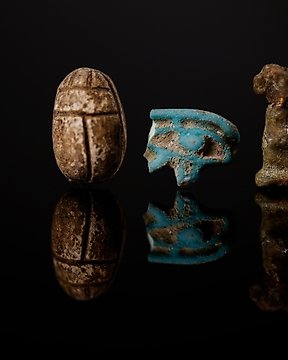
Altägyptisch Amulette von Thoth, Udjat und ein Skarabäus - 1.5 cm
Nr. 83493109

Nr. 83493109

Big Sarcophagus lid cover.
- Nice colors -
- With inscripition on the feet -
Ancient Egypt, Late Period, Late Period, 664 - 332 BC.
Wood, stucco and painted in color.
177 cm height. 42 cm length and 22 cm depth.
Provenance: Private collection, Paris, France. Acquired in Couteau Begarie, 24 March 1994, lote n°85. Ex. old parisian collection, c. 1975.
CONDITION: Good general condition, with repainting in the centre of the collar and in the knee area.
DESCRIPTION:
Egyptian sarcophagus made of wood, with base and lid in relief, anthropomorphic, decorated with pigments applied on stucco, in white, black, green, pink, red, yellow and blue tones. It represents the mummified deceased, with large eyes outlined in black, wide tripartite wig and large Menat pectoral necklace, imitating the colored faience beads in the form of a drop that they used in daily life. The body, wrapped in a white shroud is undecorated until the area of the feet, where there is a horizontal register of hieroglyphic writing in black. On the head stands out the figure of a scarab dung beetle, incarnation of the god Khepri, symbol of the rebirth of the Sun, represented as god Ra under the scarab as a yellow circle, associated to the rebirth in the Beyond of the deceased.
Death was considered in ancient Egypt as the transition between earthly life and eternal life; After it, if the judgment of the soul could be overcome, a new existence began in the Kingdom of the Dead, ruled by Osiris. Every person was composed of a physical body and several spiritual aspects, including the life force or ka and the soul or bai ; For the deceased to achieve eternal life, it was necessary that the ka and the bai could return to the physical body, which was therefore preserved through mummification and protected by sarcophagi and funerary wrappings duly decorated with images and texts of a magical nature. Sarcophagi were mostly made of wood, although those of some kings were made of gold and silver, and even stone examples have been preserved. Rectangular in shape in early times, from the middle of the 2nd millennium BC they took the shape of the mummy, incorporating a funerary mask. From the Third Intermediate Period onwards, this anthropomorphic wooden sarcophagus was usually replaced by the cartonnage funerary wrapping, whose flexibility allowed its shape to be modeled directly on the mummy and was a cheaper and easier material to manufacture.
The sarcophagus is therefore one of the most important objects in the funerary context, as a container and protector of the mummy on a physical and magical level. In the early days it will be considered the home of the deceased, and therefore it will be decorated with paintings that reproduce the façade of a palace. Soon hieroglyphic texts will be incorporated with spells that protect the deceased and guide them on their journey to the afterlife, reinforcing the magical function of the sarcophagus. The rest of the decorative motifs will change as religious and magical notions evolve; Depending on the period, the representation of one or another gods, symbols and spells will be preferred.
Notes:
The seller guarantees that he acquired this piece according to all national and international laws related to the ownership of cultural property. Provenance statement seen by Catawiki.
The piece includes authenticity certificate.
The piece includes Spanish Export License.
#ExclusiveCabinetofCuriosities
So kaufen Sie auf Catawiki
1. Etwas Besonderes entdecken
2. Höchstgebot abgeben
3. Sichere Zahlung durchführen